The first months of life, your baby smiled a toothless smile. And suddenly a small whitish bulge becomes visible on the gum. This means that the child’s teeth begin to cut, first the first, and after two or three weeks the next one will follow. (By the age of three, the baby will “acquire” all the milk teeth.)
When the first teeth are cut
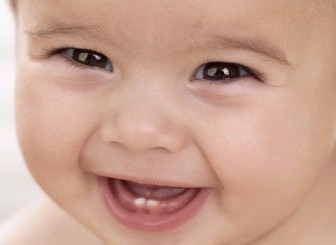
When a child begins to cut his first teeth, it depends on several factors:
- Heredity.
- Baby food. Is there enough calcium in the small body?
- Climatic living conditions. In children living in hot climates, teeth erupt earlier.
- Gender of the child. In girls, teeth are cut earlier than in boys (between 6 and 7 months).
In what teeth are cut first, pediatricians are unanimous - these are the lower incisors. Although there are cases that other teeth erupt in the first place, and that’s okay, because each organism is absolutely individual.
Signs and symptoms of tooth appearance
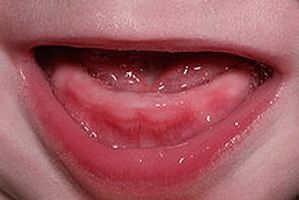
The frequent question “how do I find out / see / understand that a child’s teeth are being cut is a rhetorical question. According to the state and behavior of the baby, everything will immediately be visible:
- redness and swelling of the gums is observed, they itch and hurt;
- salivation increases;
- a sour breath appears due to decomposition of particles of the mucous membrane;
- cheeks swell;
- the child pulls everything in his mouth and scratches his gums;
- irritability and tearfulness appear.
Sometimes more disturbing symptoms appear., because the child’s immunity is reduced at this point. The baby already used that immune defense that the mother gave, and own immunity just starting to be developed. Teething is a strong blow to the body and may be accompanied by the following manifestations:
- the rash on the gums in the form of red vesicles that contain fluid, after the appearance of the tooth, the rash disappears;
- fever caused by gum disease should not last more than three days;
- diarrhea is due to the presence of foreign objects in the child's mouth;
- lack of appetite is caused by painful gums;
- sleep impairment;
- runny nose.
Scheme and teething time
- The first four teeth (upper and lower incisors) appear by 7-10 months.
- The next four incisors crawl out on their first birthday.
- The first molars from above and below will appear from a year to a year and a half.
- Fangs erupt in the second half of the second year of life.
- The second molars complete the row of milk teeth by the third year.
(Clickable)
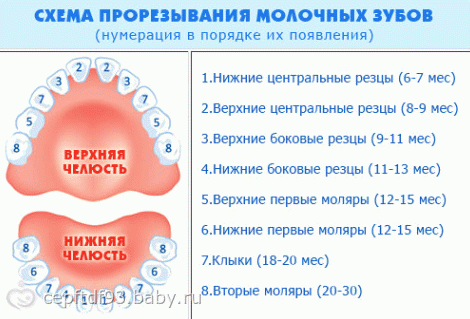
The list shows that it is impossible to say the exact date of teething.
Most often, the first teeth begin to appear about seven months, but this is not a postulate.
Late teething should not be a cause for panic. Previously, the late appearance of teeth was considered a sign of rickets or a lack of calcium. Modern pediatricians consider teething delays a normal occurrence for healthy children.
Some atypical periods of the appearance of teeth can be indirect symptoms of disorders in the body of the child:
- teething later two or more months may be the result of an infectious disease, metabolic disorder or impaired bowel function.
- teething of the first tooth earlier two months may indicate endocrine disorders.
- teething outside the gum is the result of an incorrect position of the axis of the tooth.
- the birth of a child with teeth occurs, although rarely; these teeth are removed to make it convenient for mom to breastfeed.
However, only a thorough thorough examination of the child will confirm the presence of certain violations.
If the teeth of a one-year-old child have not begun to grow, you should consult a dentist. Most often, upon examination, the doctor will find swollen and reddened gums. You just need to stimulate the appearance of teeth with massage. In rare cases, the diagnosis is adentia, confirming the complete absence of tooth primordia.
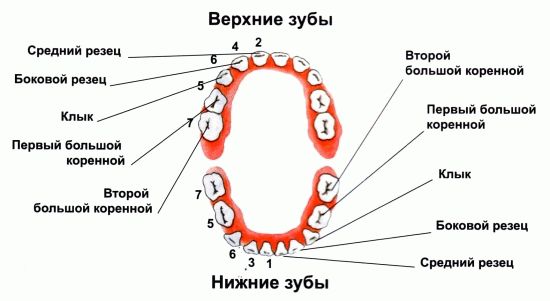
How to help a child
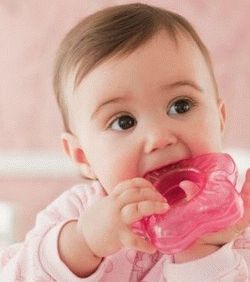 In this difficult period, you need to know how to help the child, ease his pain and discomfort. The methods are simple and worked out over the years:
In this difficult period, you need to know how to help the child, ease his pain and discomfort. The methods are simple and worked out over the years:
- Gum massage will relieve pain. You need to hold it with your finger, before washing your hands thoroughly. Massage carefully so as not to injure the gums.
- Give the baby a teether toy. The choice of such rubber, silicone or gel accessories is large and you can purchase them at a pharmacy or children's store (read about teethers).
- Cold helps relieve itching and gum pain. It is necessary to moisten a soft cotton towel in cool water, put it in the refrigerator and let the baby chew. You can use a decoction of chamomile instead of water, it will help relieve inflammation. You can also cool the gel teether or pacifier.
Old, proven methods can be supplemented with modern pharmaceuticals. Now in pharmacies there is a large selection of special gels and during pain in a child, you can choose any and lubricate their gums:
- Dentinox;
- Holisal;
- Calgel;
- Baby Doctor;
- Kamistad;
- Denthol Baby;
- Pansoral.
Teething is a delicate process that requires parental involvement and care. Soreness and swelling of the gums, irritability, increased salivation, which may be accompanied by a wet cough and runny nose, increased stools - these are the main troubles that the baby will have to endure if nothing is done. To alleviate the condition of the baby during teething, we advise you to pay attention to Dantinorm Baby, a completely natural preparation that, thanks to the complex action of plant components, helps to relieve all the main symptoms of teething in a child, helping parents and babies to calmly overcome this period.
Read more about gels: TOP - 7 teething gels
If severe pain occurs, you can resort to an anesthetic. Before giving your baby a medicine, you should definitely consult your doctor.
Excessive salivation irritates the baby's delicate chin skin. It is necessary to constantly wipe the saliva and lubricate the skin with baby cream. During this period, it is necessary to remove from the environment of the child all small and fragile objects. The kid pulls everything in his mouth and can get hurt, swallow the item or suffocate. All baby toys must be disinfected for the same reason.
First teeth care
The first teeth of the baby require new responsibilities from parents. Even one tooth already needs to be cleaned - this is hygienic need, and the formation of a good habit to take care of clean teeth. To do this, buy a special silicone nozzle on your finger or use a bandage soaked in boiled water. The procedure is carried out regularly: after breakfast and in the evening, before going to bed, carefully rubbing your teeth, gums and tongue.
A little later, they begin to use a children's toothbrush with soft bristles and toothpaste with a minimum fluoride content. You need to change the brush every month. It must be used carefully, because the enamel in the first teeth is thin and its integrity can easily be violated. Parents should brush their teeth, only after two years a child can start brushing his teeth himself, but only with adult control. It is important to immediately teach the baby to regularly and properly brush his teeth - this will save him and his parents from many dental problems in the future.
Funny calendars
Print your favorite teething calendar and don’t forget to fill in 🙂
READ ALSO ::
Mom’s school: The first teeth are cut. How to help baby

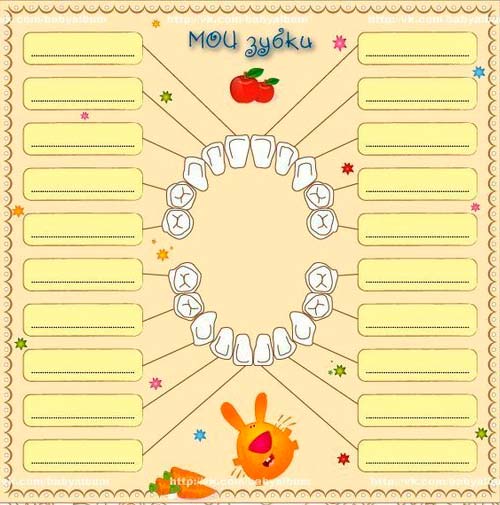
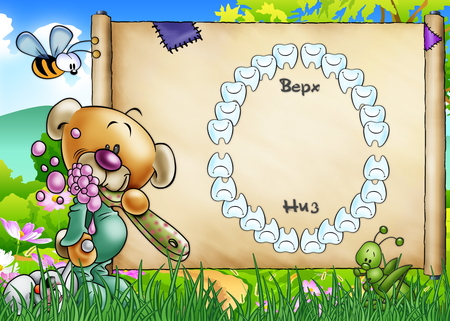
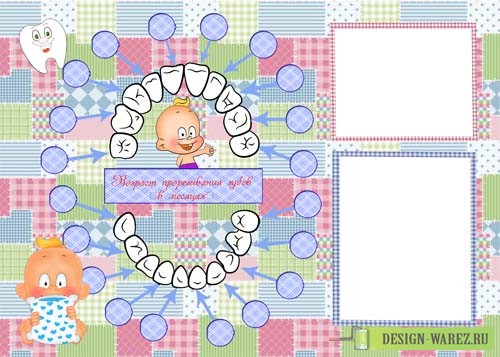
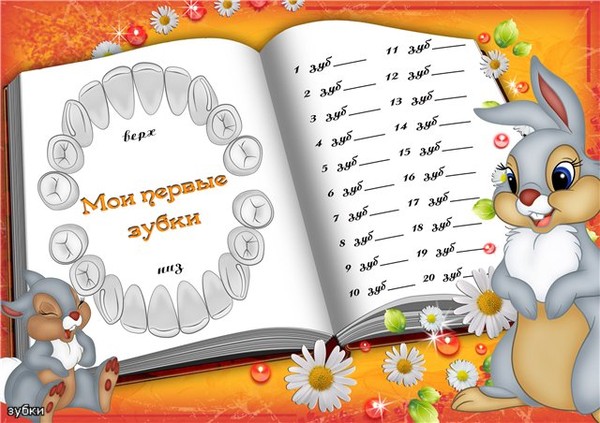

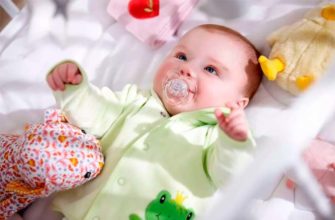
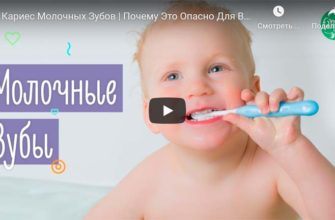
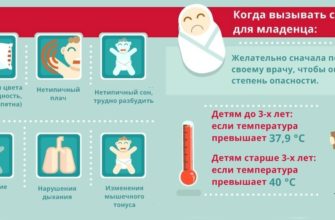




Part of the article is complete nonsense. All people and children, including very individual. You can not all fit in one comb.
When teeth are cut, it is still more of a problem than joy. it's very difficult to argue.Although, we still had more joy. And all because they used Solcoseryl paste. The pain relieves very quickly.
Our son is 10 months old and we have 12 teeth. The first two teeth erupted in 4 months and 2 days. By the end of 4 months, 4 teeth))) Our doctor is in shock !!! Calls us the accelerate))))))))
Our teeth are now being cut, and the doctor advised me to apply Solcosril paste. I am so pleased. My baby sleeps well, eats, behaves calmly. In general, for us, everything goes smoothly, in the literal and figurative sense)).
My son is 7 months old, but there are no teeth yet. Although the symptoms were, right in the mouth ... And the gums itch, I hope they’ll come out soon. But I’m worrying ... By 7 months, teeth should usually erupt
My daughter is 3 months old. It seems to me that her teeth are being cut, as she freaks out, bites her fists, fever, runny nose. Tell me what to do, and is it possible to give the child Ibufen (I was advised)
Molar (permanent) teeth appear only after temporary (milk). The molars named indigenous in the article are not !! Correct the article please. Right away, only premolars erupt.
Dantinorm Baby, try it natural without ice cream. These drops always help us
Dantinorm great drops, they also took
we have 2.5 months and teeth begin to erupt but for some reason fangs with what it is connected
the second baby leader helped us with the second molars. anesthetized very quickly. Well, teething, too, of course used.
My baby is 2 months old, drool is excreted and it makes me sick. Does it just happen?